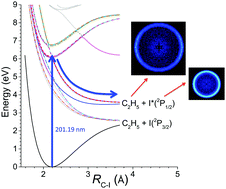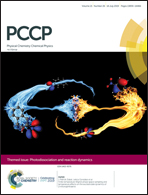Dynamics of the photodissociation of ethyl iodide from the origin of the B band. A slice imaging study
Abstract
The photodissociation dynamics and stereodynamics of ethyl iodide from the origin of the second absorption B-band have been investigated combining pulsed slicFe imaging with resonance enhanced multiphoton ionization (REMPI) detection of all fragments, I(2P3/2), I*(2P1/2) and C2H5. The I*(2P1/2) atom action spectrum recorded as a function of the excitation wavelength permits one to identify and select the 000 origin of this band at 201.19 nm (49 704 cm−1). Translational energy distributions and angular distributions for all fragments and semiclassical Dixon's bipolar moments for the C2H5 fragment are presented and discussed along with high-level ab initio calculations of potential energy curves as a function of the C–I distance. A predissociative mechanism governs the dynamics where in a first step a bound Rydberg state corresponding to the 5pπI → 6sI transition is populated by the 201.19 nm-photon absorption. A curve crossing with a repulsive state located within the Franck–Condon geometry leads to direct dissociation into the major channel C2H5 + I*(2P1/2). A small amount of I(2P3/2) atoms is nevertheless observed and presumably attributed to a second curve crossing with a repulsive state from the A-band.

- This article is part of the themed collection: Photodissociation and reaction dynamics


 Please wait while we load your content...
Please wait while we load your content...